Feature Interview with Bob Harrison
April 2000
Based in Sydney, Australia, Bob Harrison is the head architect for the Greg Norman Golf Course Design for Asia Pacific and has been involved with course design around the world. Common with most architects born in Australia, Alister MacKenzie was a particular influence and this manifests itself in Bob’s work. Greens that slope away, wide fairways and half-par holes all add up to courses that are both fun and challenging without undue insistence on length. Two of his courses – the Moonah Golf Course at The National and Nirwana Bali – are reviewed elsewhere in GolfClubAtlas.com.
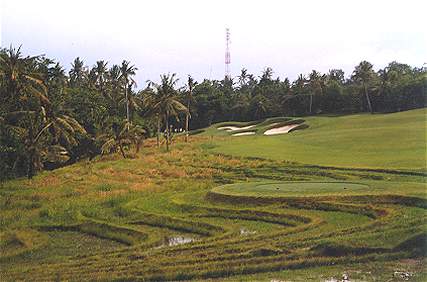
Nirwana Bali and its original opening hole complete with rice paddies.
1. What are your recollections from meeting John Arthur Brown?
I met John Arthur Brown when I stayed at Pine Valley for a week many years ago. He was then in his nineties and had already been President of the Club for over 50 years.
Over a period of a day or two we had breakfast and lunch at the Club and went around part of the course. I was young and somewhat in awe of this legendary figure. For a bloke of his age he was impressive. Very big, upright and in command of his wit. He told many stories about John Arthur Brown – and referred to himself in the third person. But it didn’t seem to matter, you couldn’t achieve what he did without a prominent ego. Even at this late stage in his life he apparently still controlled the members as if they worked for him.
Eb Steineger was the Superintendent at the time, and had been so for 50 years. He and Brown had developed the course together, and it had changed drastically from what photos showed of the course in its early days. Eb doubled as the Fire Chief and other civic duties as well. Brown was the Mayor and the Police Chief, I think. This happened because Pine Valley was not just a golf club, but its own district.
2. Where would you rather have a game – Muirfield or North Berwick? Why?
The proof of the pudding is in the eating. The last six times I’ve stayed in North Berwick I played on the West Course but not at Muirfield. Perhaps this is partly a reaction against the general overrating of Muirfield. It’s obviously a good course but in my opinion doesn’t deserve to be rated anywhere near the top ten in the world. And while it’s demanding, I don’t find most of it particularly inspiring. The hype probably gained momentum from Jack Nicklaus’ high opinion of the course – and that’s got to be questionable fuel. That, and the fact that it’s regarded by Americans as the ‘fairest’ amongst the Scottish courses. (in my opinion, fairness should not generally come at the expense of inspiration or fun.)
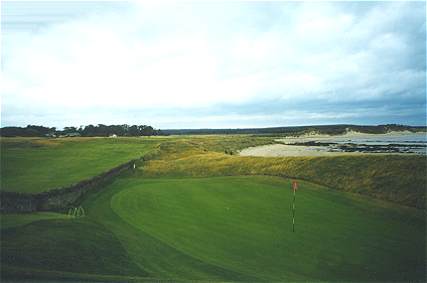
The stone wall and the sea give the edge to North Berwick.
North Berwick on the other hand is quirky, unusual, interesting, and has an old-world charm as well as being located along a beautiful strip of beachfront. Where else would you find half a dozen greensites right along the beach – even amongst links courses? It’s fun to be playing in and out of old stone walls and come across such gems as the 13th where the wall dictates the strategy and the hole lies right beside the ocean.
Even though I enjoy North Berwick, I’ve suggested to Ran that I’m not sure whether it is a great course. Consistently he responds ‘Where does it rate among courses you most want to play?’ Interesting point and North Berwick is certainly near the top.
3. If time or expense weren’t considerations, which five courses would you most like to see for the first time?
(a) The National Golf Links of America
(b) Shinnecock Hills
(c) Sand Hills
(d) Westward Ho!
(e) The three top courses in Adelaide
I’ve never been to Long Island but from reports and photographs it appears to have the sort of charisma that sets aside locations such as Monterey. Greg speaks very well of Shinnecock Hills and the old-world style of The National appeals to a number of people whose opinions I respect.
While world course ranking systems are sometimes way off the mark, Sand Hills’ performance is amazing – I’m keen to get there and see what all the fuss is about.
The few photos I’ve seen of Westward Ho! look flat and uninteresting and Stuart Woodhouse gave it the ‘thumbs down’. In fact, he walked away and didn’t play. But there are so many contrary opinions and it’s located in one of the most attractive parts of England. I’m looking forward to seeing it in July.
4. Tell us about your new Moonah course on the Mornington Peninsula in Australia.
This is one of my favourite areas in Australia and has been described as Australia’s answer to the Monterey Pensinula. At the west end it starts with the seaside suburbs on Port Phillip Bay and progresses down the stretch of beach where the golf courses will be located to Cape Schanck (named for golf). The National Parks lie along the eastern side overlooking sheer cliffs and the ocean to Phillip Island – the 500 cc venue. Inland from the ocean the land rises to a series of hills, which feel like Old England. This is where all the boutique vineyards and the restaurants are located.
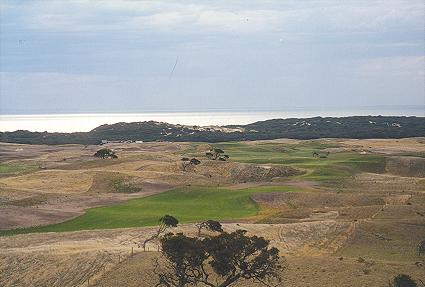
The stunning dunescape wih the Pacific in the background.
Ran recently reviewed our course in detail on this site. He raised the question that land can sometimes be too dramatic for good golf and I sense skepticism amongst some members of this Discussion Group about the distracting quality of ‘eye candy’.
My own view is that it is always vitally important, and worthwhile effort, to make every hole look attractive and the overall course as spectacular as possible – whatever the quality of the natural land. We give this aspect of design a great deal of attention. Hopefully, this effort is never at the expense of strategy. Both are important and they should complement each other.
However, parts of The National are so spectacular that some of the holes are dictated by shape. We went where the land said to – even if the result was penal (certainly intimidating). While a few of these holes are less strategic than the others, they are very worthwhile and give the course variety. Plus they will be great fun to play.
A good example is the 380 yard 11th which is great fun even though there are no real options from the tee. The drive crosses a series of ridges to an elevated valley between two massive dunes with the wild coastal dune as a backdrop. It looks totally wild and intimidating from the tee and you must drive it straight. Not a lot of strategy off the tee but the hole is a natural – we would have been crazy to do anything different given the shape of the land. The short second is played across a series of wild bunkers about 30 yards short of the punchbowl green and 3-4 yards higher than it. The smart shot to the right half of the green is to lob it just over the bunkers and let it run down to the green. When the pin is on the left, it’s best to carry all the way.
It saddens me that most ‘Golf Architects’ do not really understand the basics of shape and harmony and would benefit from a course at art school. There are 5-6 design principles which would really help.
This subject of harmony raises the question of Seth Raynor. I’ve had very limited experience of Seth’s work – a visit to Camargo last October. This is a beautiful, natural property but in my opinion the course fell down where the designer’s work was evident. Some of the greensites were just totally separate lumps of dirt which don’t really belong with the rest of the landscape.But even before seeing Camargo I wondered why you would discuss at such great length the merits of an artificial, engineered approach.
Surely good design can achieve the same strategic objectives without such a lack of harmony?
5. What five holes (from different courses) do you wish you could say you designed?
13th at North Berwick
14th at New South Wales
17th at St Andrews
12th at Augusta
5th at Royal Melbourne
These are all short holes, with the exception of the Road Hole. It’s an interesting exception because it’s an example which demonstrates (by exception) the sadness of conforming with the ‘rules’ which have crept into golf design over a long period. There are still many golfers who will argue strongly, for example, that fairway bunkers on a long par 4 should always be shallow to allow a long approach. What nonsense! It was disappointing watching the Honda Classic a few weeks ago to see pros hitting 2 irons to a few feet out of what appeared to be nothing more than huge, flat sand pits.
Back to the Road Hole. Imagine explaining the design of this hole before it was built. ‘Well, there will be out-of-bounds on the right side and you can drive diagonally across it if you choose. The wind will often blow from left to right and there’s going to be a railway shed in front of the tee so that the drive is often blind. We’ll make the hole 465 yards and call it a par 4. To put some spice in the second shot we’ll have a table-top green with a road and stone wall just behind it. And on the front left there will be a very steep, deep, small bunker which even part of the green rolls into. Now add a 1 to 2 foot downslope in the green away from the bunker and towards the road.’ Despite all of this, the hole is great fun, is strategically interesting, and occurs at a vital part of the course.
So, throw the ‘rules’ out – within reason. The 4th at St Georges is 460 yard par 4 brute, but has a wild, smallish green and fairway bunkers 30 feet deep – but it’s great fun.
The 14th at New South Wales is a mind-blowing spectacle across some massive sand ridges high above the ocean. You have to drive over one of these ridges to the valley beyond, and this shot is much shorter to the right but leaves a much longer second to the green above the cliff to the left. In some conditions the hole might even be reachable in one – so the strategy matches the glamour. Another very interesting feature of this hole is the extreme shape of the fairway. If you analyse the contours on a drawing you would not be brave enough to leave them alone. So while it’s not always the case, this is an example where bulldozers in the modern era might have ruined the natural advantage of the land.
6. Does seeing what a Greg Norman can do to dismantle a course influence your designs?
Somewhat and hopefully only for the good. For instance, I have seen him drive the green on the 11th hole at The Medalist It is staggering to see an awesome display like that and I try to build courses where talented golfers are given a realistic option to pull off such heroic shots. I think we particularly succeeded in doing that at The Grand where all the par 5’s are reachable (but at an expense if you fail) and one of the par 4s may be drivable in certain conditions as well. This so called Tiger-proofing makes me sick. I would much rather try and create drama than stifle it and half par holes do that exceedingly well.
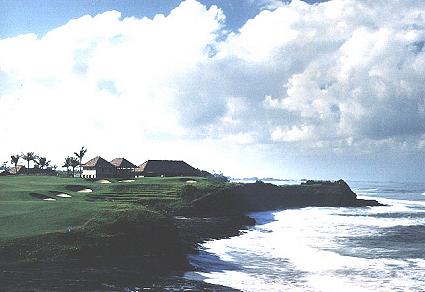
A great gambling hole is the 13th at Nirwani Bali. It requires a carry of 320 yards and any score from a 2 to a 7 is possible.
7. What is your favourite short par 3 (under 140 yards), par 4 (under 340 yards), and par 5 (under 500 yards)?
Short holes are becoming more popular with architects these days and rightly so. They always have been with me and many years ago over a number of jars in North Berwick I suggested to Brad Klein that we develop a book about the world’s best eighteen made up of short holes. We never followed through by I understand he’s written several articles since.
The obvious par 3’s under 140 yards are the 7th at Pebble Beach and the 8th at Troon. These are terrific holes but I think my favourites by chance are around the 150 yard mark such as the 12th at Augusta.
The short list for the par 4’s would include the 1st and 15th at Prestwick; the 3rd and the 10th at Royal Melbourne West; 14th at New South Wales; 9th at Cypress Point; and the 12th at St Andrews.
I’ll nominate the 13th at Augusta and the 4th at Royal Melbourne West for the par 5’s.
8. What course is a personal favourite with which perhaps the readers may not be familiar? What do you like about it so much?
I’d like to nominate two courses: Newcastle in Australia and Nirwana Bali.
Don’t be fooled because they allowed Ran to be a member at Newcastle – this course is outstanding – and could be much better. The course is built on rolling sand hills near the ocean. Each hole is carved out of the Aussie bush and there is a pleasant feeling of isolation on most. But the real beauty is the shape of the terrain and the varied and dramatic ways in which it is used.
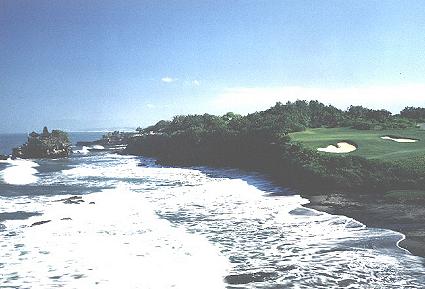
Easy to see why the Nirwana Bali course is a favourite - this is the view from the tee of the 185 yard 7th.
The par 5 10th is one of my favourites. After a slightly elevated drive to a plateau which plunges downhill at the distance of a long drive, the remainder of the hole plays across a series of domed hills which fall away on either side to bush. The green is blind behind the last of these unless you reach the crest with your second. The intimidating drive on the 5th plays into a funnel which runs diagonally towards the green with a large ridge to the right. The safe shot with a 2 or 3 iron leaves a long second. If you’re going with the drives there’s no room to miss but the reward is a much easier shot. From the tee, the shape looks almost too wild (as only nature can do) to be possible.
As for Nirwani Bali, the ocean holes along the cliff tops are a real knock-out and I hope that they also have strategic interest and variety. It was challenging to get the best from such a wonderful site, but even more challenging and rewarding to give the inland holes a character and style which would stop them becoming poor cousins to the ocean holes. The character was achieved by constructing large areas of rice terraces throughout the roughs to create the illusion that the course had been laid out through them, and to make the holes spectacular to look at and Balinese in flavor. These are properly functioning rice fields and are farmed by the local people. The planting of different areas is staged so that at any one time some sections are nearing harvest, some are wet and others are green.
9. How do you think this period in course architecture (1985-1999) will be viewed in fifty years time?
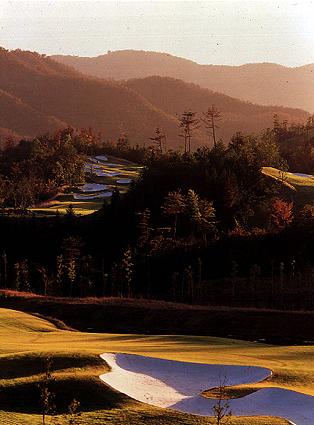
The extreme topography found in Japan.
This has been the era of signature design and, in 50 years’ time, commentators will probably note that the influence of the pros varied considerably in both extent and quality. They’ll hopefully conclude that playing good golf and designing good golf are two separate skills – one sometimes leads to the other, but not always.
This has also been the era of large-scale earthmoving. It has become progressively easier (and common practice) to revise what the natural land offers. In the hands of some designers this is a considerable benefit. In some hands it’s a bit of a disaster.
On most properties it’s necessary to create at least some of the features and shape. Machinery enables you to do this in a less localized fashion and to tie the created shapes better to desirable existing ones.
It also enables you to completely fabricate a continuous, attractive shape over a whole project if necessary and to make it look like you were lucky enough to find this shape and drop the holes onto it – rather than the reverse. And these days many of our projects are on flat, flood-prone land (Sanctuary Lakes, The Glades and Pelican Waters) so this shaping resource is very important and can be of great benefit. The sad thing is that it sometimes takes away the requirement for designers to find best solutions – bad planning can be compensated with earthworks.
An interesting spin-off of the earthmoving era is what is has made possible in Asia. In many parts of Asia in the last decade or two golf courses have been constructed on mountainous country which is not at all user-friendly and would never be considered for golf in most parts of the world. Japan, for example, has an overall shortage of useable land and all available is earmarked for commercial, residential and agriculture. The mountains are the only land available for golf.
My first experience of this was in Taiwan. Our site had slopes of 1:3/1:2 up to 600 feet high. Having no experience of such terrain I was shocked at being asked to put golf in it. So we went to see a nearby project under construction and were truly amazed. It was Star Wars! Twelve D10 dozers, 15 or more huge excavators and an army of trucks were literally moving a mountain into a valley to create a workable site.
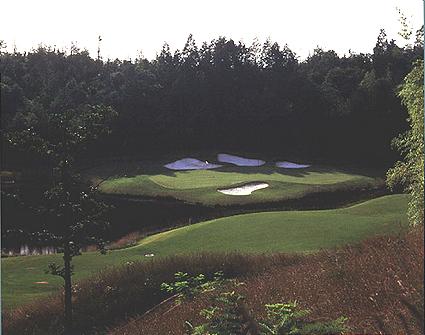
This lake on the 3rd at Osaka is actually 120 feet above the natural ground level.
In such terrain cuts are often 180 feet deep and fills up to 150 feet. On one of our Philippine projects a local architect had convinced our client that 1,500,000 cubic yards of earthworks would be needed to produce a golf course and residential lots. The client bought the property on the basis of this dubious advice and engaged us. We are now in the process of moving 17,500,000 cubic yards! It’s an amazing sight, but the story is not all bad. We built Himeji Shirasagi (near Kobe in Japan) in mountainous terrain and it is a beautiful place. The 14th green shown in one of the photos was constructed on 140 feet of fill, and the lake shown in front of the 3rd green is actually perched 120 feet above the natural ground level. Especially for commercial reasons, good design is more important on extreme sites. Reducing earthworks volumes by a few million cubic yards can greatly reduce the project cost.
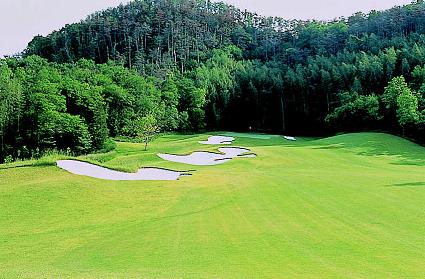
The 14th green at Osaka sits on top of 140 feet of fill.
Getting back to the 85-99 era, I think it probably needs to be divided. Somewhere in this period the penny began to drop that lush green grass from one boundary to the other was not the way to go. Not from an environmental standpoint and also not from an aesthetic standpoint. In more recent years there seems to be a move towards less turfgrass, more native grasses and a better result. I hope that in 50 years’ time this period will be remembered for the beginning of this transition.
I have one last gripe about the modern era on a much more mundane level. This is also the era of STRIPES. There are so many stripes on some holes these days that they look like mazes. Stripes in the rough for God’s sake! Stripes on the greens are fine, and maybe a second lot on the fairways would be sometimes acceptable. But in my opinion there should not be any differentiation between fairway and approach, and definitely no pattern at all in the roughs.
10. What fives courses are ‘must-sees’ for a student of golf course design?
- Pine Valley
- The Old Course at St Andrews
- Royal Melbourne
- Several modern courses
- Macrahanish/Lahinch/North Berwick
I think they would benefit from a mixture of good and bad. Variety would be important.
For the value of strategy and the intricate, interesting and almost ‘unfair’ shaping of greens, St Andrews would be a must. The Old Course would also help to demonstrate the value of chipping and firm, fast surfaces. Without being rude, this would make it particularly appropriate for American students.
To see the most beautiful and dramatic bunkering and greensites, and to absorb the values of grandness and scale – Royal Melbourne. Royal Melbourne is also a powerful example of how to merge edges of the bunkers and the wilderness in the roughs to help fit the course into the landscape.
It’s important not to carry too much baggage about ‘fairness’, ‘luck’ and ‘rules’ so I would send them to Macrahanish, North Berwick, Lahinch, etc., for the fun of it and to absorb the atmosphere, the quirkiness, the charm and the wildness.
Now I have to be careful. They should also visit the work of a few reasonably prominent current architects for comparison. Mogul mounds that don’t fit the surrounding shape. Discontinuous shape between fairways and roughs. Slitty bunkers without character. Areas of green grass, etc., etc.
Pine Valley for the experience.
11. What are your thoughts on Merion among the world’s great courses?
I am a Merion fan and it’s great to see a 6700 yard course regarded so highly. However, it’s not in my upper echelon, partly because it doesn’t have the inspiring feeling that comes with grandness of scale. To me grandness is an important quality and is one of the factors which separates Royal Melbourne from Kingston Heath (for example).
This was a topic of heated debate at Lost Dunes last October – fueled by a grand scale of red wine. Stu Woodhouse and I both like Merion and agree that it was an accomplishment to create a course of such quality on such a small property. But, while we acknowledged this feat, we do not think that it should have any influence on the overall standing of the course. If other quality courses stand out because of the added advantage of scale and glamour – or for other reasons – so be it.
12. What five links courses do you most enjoying playing?
- Royal St George’s
- The Old Course
- Macrahanish
- North Berwick
- Barwon Heads
13. Is there a particular feature that is generally considered antiquated (cross bunkers, punchbowl greens, etc.) you think is missing from course design today?
I don’t know that we miss cross bunkers so much. Perhaps, now and then, they might help. I’m not sure that any one feature needs to be reinstated, but I think design has become too rational and often dependent on ‘formulae’. Long par 4’s, for example, are supposed to have large flat greens and shallow fairway bunkers. If a hazard is placed where you would otherwise hit your shot, it is unfair. And so on.
Am I advocating design anarchy? – No. There has to be sense to what is done and some degree of reasonableness. This is where skill and judgment come in and separate brilliant from ridiculous.
Chipping has gone from a lot of courses, particularly in the USA. This is a product of design in some cases and of the way in which courses are presented in others. I would like to see more emphasis on firm, fast surfaces and delicate chipping.

The punchbowl 11th at The Moonah course.
We have some punchbowl greens at The National, but this is a links course in sand. It’s technically harder to do in clay country, but you can get close. Punchbowl greens aside, greens that run away from you can be extremely interesting and are not so common. In my view this is one of the most interesting features of St Andrews where the strategy of many of the holes is dictated by these downhill slopes.
14. As a designer, what would your preference be for a maximum obtainable Stimp reading? How would that change how you build greens?
In Pete Dye’s recent book ‘Bury Me in a Pot Bunker’ he argues for slower greens – as low as 6 on the meter.
Historically this was how the greens were, even on famous courses – even at the Masters. A documentary on very old Masters tournaments has been running on Aussie TV lately and it is amazing how slow the greens were. This is no great revelation, but slower greens were the status quo for architects in those days, and the greens were often more severe as a result. Crystal Downs is a great example. I saw this course for the first time last October with Tom Doak, Ran and Richard Sheppard. The greens were extreme. In fact, some were almost unputtable – 10, 11 and 13. But they were never intended to have today’s speeds.
I like faster greens so my answer would be to produce slightly softer versions of the same shapes. I think our greens are probably in the middle range of shape and their contours are designed to form part of the surrounding shape. Greens should be surfaces with overall, continuous shapes. Of course, if you have fast greens they have to be true. In the old days when Royal Melbourne’s greens had a brown, mottled appearance (which was held to be unsatisfactory for aesthetic reasons, and hence the change to Pencross Bent which ruined them) they were lightening fast. However, you knew as soon as a 30 foot put had gone 3 feet whether it was going in – they were that true. Part of the secret was that there was very little grass on them.
15. What is it like to work with a professional golfer like Greg Norman?
I’ve talked elsewhere about signature design. Whatever your readers think of it, it’s a fact of life in an era when marketing pressures dictate. As with most things, the results are mixed.
In my own case I’m lucky to have teamed up with Greg twelve years ago. We want our golf course business to succeed commercially but, more importantly, we want to create good and memorable golf courses. It’s a passion, and I couldn’t work with a celebrity pro if I didn’t share the same overall philosophy about golf courses. The pro’s approach would rule and you would just be doing a job if you didn’t agree. I doubt that I could have worked for many of the big-name pros for this fundamental reason – perhaps I’m wrong. However, agreeing on an overall approach doesn’t mean you agree on every detail and there’s a lot of to’ing and fro’ing to get the best out of each situation.
For obvious reasons Greg is more ‘hands on’ in the USA than in Asia or Australia. He comes to Australia two to three times each year and catches projects at various stages of development. So it’s important for me to be as prepared as possible so that these reviews are based on good framework and produce a better result than one person alone would achieve. Most of the time this is the way it goes. Occasionally playing with Greg is part of this routine and a real awakening process.
The difference between what the top line pros can do to a course and what we mere mortals do makes some aspects of design very difficult. Bunkers, for example. The pros are so good out of these that to impose any difficulty for them at all can often make them unworkable for other golfers. It’s interesting that amateurs find this shot so difficult. Landing areas also become difficult. You can’t have too many instances where the fairway drops steeply downhill at less than 270 yards. Once or twice is OK, particularly on a links course such as The National where wind conditions greatly influence the result. The 11th at The Grand is an interesting example. For most of us it’s hard enough to reach the crest of the hill to have a view of the green across the creek. If the top pros drive it far enough to get the advantage of the downslope, the second shot becomes a wedge.
16. Some courses like Pine Valley and The Medalist Golf Club are clearly designed with the better golfer in mind. Would such courses be more fun to design?
When questioned about their overall approach, most modern Golf Architects have a number of answers which appear to be achieved by pressing buttons. One of these is that ‘we make our courses playable for all levels of golfer’. Some should be hung for this quotation. In reality you have to try to achieve this balance between making a course interesting for the best players and interesting but reasonable for the hackers. It’s an interesting part of the equation but I have to admit that all sorts of possibilities open up if this restriction is taken away.
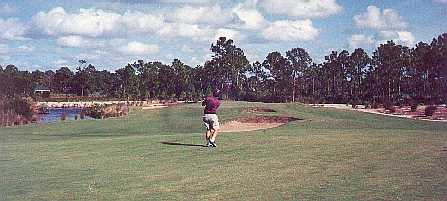
The Medalist appeals to the better player.
Medalist would perhaps be an example of this. While it gets good critical reviews in the U.S., there are apparently those who criticise it for not giving every level of player a chance. But this was never the intention. They correctly recognised that there was an opportunity to satisfy part of the marketplace which wasn’t being catered for – golfers off about 10 handicap or better. And because Medalist was designed for better players, it enabled them to make very creative use of the land. There are something like 40 acres of tee, green, bunker and fairway in a 400 acre swamp. What a great way to design a course if circumstances allow. You don’t ruin the environment and you make it a spectacular place to play.
By coincidence we’re working on a very private inland course in Australia at the moment which will probably have only 5 to 6 players a day – and those players are known to be reasonable golfers of The Medalist calibre. The site is dominated by a beautiful creek and the knowledge of who the players will be has enabled us to take many spectacular chances in designing the holes which we might not otherwise have done. There’s no doubt that this is great fun and with luck this course will become famous with people clamouring to play – probably without being able to.
17. You have designed courses in Asia, the United States, and Australia. Are there any unique requests from clients in any of those countries?
Individual clients in any country have different approaches. Some leave you alone and at the other end of the scale some are desperate to be part of the process on a day-by-day basis.
If they have one general approach – at least in Asia – it’s probably the fear that you’re making the course too tough. We had one example of this in Indonesia when our Japanese client, who was a great bloke but a very moderate golfer, would each weekend review the design with a bunch of his Japanese golfing buddies. He took their opinions to be gospel at the expense of ours. This can be a really frustrating process.
On the other hand, Phil Wente had a very unusual approach when we were laying out the centrelines at Wente Vineyards. We’d walk across a hill and Phil would say ‘Let’s have a lake here.’ ‘But Phil, it’s blind from the tee.’ ‘Ah, don’t worry . . . let’s have a lake anyway.’ His point of view was very different and he was great fun to work with.
18. Talk about course set-up.
It’s a pity to see any course tricked up and more so for a major tournament. We’d be very upset if it happened to us. The whole objective of the design could be lost and the course even held to ridicule as Carnoustie was at last year’s Open.
This question is topical for us as tournaments are played on our own courses in the USA and the same will happen in Australia shortly. We hope we have enough clout to prevent a Carnoustie, and in the some cases we own the tournaments – so these should be OK.
The supposed need for the Carnoustie approach might sometimes be a reflection on the design quality of a course. Take the opposite example. St Andrews, with 100 yard wide fairways has produced Open Champions such as Thomson, Nicklaus , Ballesteros and Faldo. No doubt which is the more appealing design between those two Open courses.
The End






